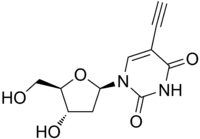5-Ethynyl-2'-deoxyuridine
5-Ethynyl-2´-deoxyuridine (EdU) is a thymidine analogue which is incorporated into the DNA of dividing cells. EdU is used to assay DNA synthesis in cell culture and to detect cells which have undergone DNA synthesis in embryonic, neonatal and adult animals.[1] Whilst at high doses it can be cytotoxic, this molecule is now widely used to track proliferating cells in multiple biological systems.
 | |
| Names | |
|---|---|
| IUPAC name
5-Ethynyl-1-[(2R,4S,5R)-4-hydroxy-5-(hydroxymethyl)oxolan-2-yl]pyrimidine-2,4-dione | |
| Other names
2'-Deoxy-5-ethynyluridine; 5-Ethynyl-2'-deoxyuridine | |
| Identifiers | |
3D model (JSmol) |
|
| Abbreviations | EdU |
| ChEMBL | |
| ChemSpider | |
| ECHA InfoCard | 100.230.902 |
| MeSH | 5-ethynyl-2'-deoxyuridine |
PubChem CID |
|
| UNII | |
CompTox Dashboard (EPA) |
|
| |
| |
| Properties | |
| C11H12N2O5 | |
| Molar mass | 252.226 g·mol−1 |
Except where otherwise noted, data are given for materials in their standard state (at 25 °C [77 °F], 100 kPa). | |
| Infobox references | |
EdU-labelled cells may be isolated to determine the transcript of cells, from neural cancer[2][3] or tissues[4] that have undergone division in vitro and in vivo.
Detection
EdU is detected with a fluorescent azide which forms a covalent bond using click chemistry.[1][5] Unlike the commonly used bromodeoxyuridine, EdU detection requires no heat or acid treatment. EdU incorporated into DNA induces DNA damage, primarily during DNA replication, which is reflected by phosphorylation of histone H2AX, arrest in the cell cycle progression and apoptosis.[6]
References
- Chehrehasa, F; Meedeniya, AC; Dwyer, P; Abrahamsen, G; Mackay-Sim, A (February 2009). "EdU, a new thymidine analogue for labelling proliferating cells in the nervous system". J. Neurosci. Methods. 177 (1): 122–30. doi:10.1016/j.jneumeth.2008.10.006. hdl:10072/25744. PMID 18996411.
- Endaya, Berwini; Cavanagh, Brenton; Alowaidi, Faisal; Walker, Tom; Pennington, Nicholas de; Ng, Jin-Ming A.; Lam, Paula Y.P.; Mackay-Sim, Alan; Neuzil, Jiri (2016). "Isolating dividing neural and brain tumour cells for gene expression profiling". Journal of Neuroscience Methods. 257: 121–133. doi:10.1016/j.jneumeth.2015.09.020. PMID 26432933.
- Endaya, Berwini B.; Lam, Paula Y.P.; Meedeniya, Adrian C.B.; Neuzil, Jiri (2016-01-01). "Transcriptional profiling of dividing tumor cells detects intratumor heterogeneity linked to cell proliferation in a brain tumor model". Molecular Oncology. 10 (1): 126–137. doi:10.1016/j.molonc.2015.09.001. ISSN 1878-0261. PMC 5528932. PMID 26388584.
- Ng, Hui Xuan; Lee, Ean Phing; Cavanagh, Brenton L.; Britto, Joanne M.; Tan, Seong-Seng (2017). "A method for isolating cortical interneurons sharing the same birthdays for gene expression studies". Experimental Neurology. 295: 36–45. doi:10.1016/j.expneurol.2017.05.006. PMID 28511841.
- Cavanagh, Brenton; Walker, T; Norazit, A; Meedeniya, A. C. (15 September 2011). "Thymidine analogues for tracking DNA synthesis". Molecules. 16 (9): 7980–93. doi:10.3390/molecules16097980. PMC 6264245. PMID 21921870.
- Zhao H, Halicka HD, Li J, Biela E, Berniak K, Dobrucki J, Darzynkiewicz Z. (2013) DNA damage signaling, impairment of cell cycle progression, and apoptosis triggered by 5-ethynyl-2'-deoxyuridine incorporated into DNA. Cytometry A. 83:979-88. doi: 10.1002/cyto.a.22396. PMID 24115313.
External links
